Guest Blog by Mike Rollet
Intro, and conclusions by Art
Greetings all, this is one of those times I get caught between a rock, and a hard place, situations. Several months ago, one of our larger dealer advertisers mentioned to me that they were introducing their own line of lower cost fixed projector screens. Further they asked: “Art, would you review one of our screens, and publish it?
Now some of you know I do an occasional “end user” review – where I write up a review of a related product, that I bought for my own theaters, and worked out well enough that
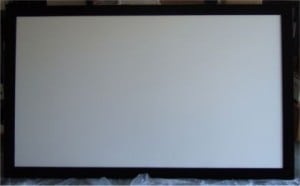
The VApex 106" diagonal projector screen looks good, with a nice 3.5 inch velour border
I thought I would share the word. I’ve done that for
Gefen and
Octava switchers and extenders, etc. In this case, however, I really don’t need one more screen, they are piled up in the garage. (Projector companies always want their projectors back after a review. Screen companies almost never do.)
I also have a bit of a problem doing what I’ll call a “private label” product review. Do one, and next thing I know, every dealer I have wants me to review their “this or that” private label product. I came up with the best solution I could, for now. The dealer/manufacturer – in this case, Visual Apex, should be happy, you should be happy, and I’ve dodged another bullet, for now.
To accomplish all this, my solution was simple. I asked Mike if he would review the screen. Mike’s independent, makes no profit off of Visual Apex advertising, etc, and Mike has plenty of experience with screens, and it’s not his first screen review, either. Besides, I just hate assembling screens. I've provided commentary, relating to pricing vs. performance starting with Mike's conclusions, and in consultation with him.
So, with all that in mind, here’s Mike’s review of the Visual Apex 106” fixed matte white screen (I have managed, of course, to throw in lots of comments at the end). -art
VApex 106" Matte White Fixed Projector Screen Overview:
With the price of some 1080P projectors now approaching $1000, the market for an inexpensive, but good-looking, fixed frame screen has increased. Visual Apex, a prominent retailer of home theater and business projectors, has addressed this need with their line of Cinema White, fixed frame screens.
Available in sizes from 92” to 135” diagonal (16:9 format only), the VApex screens feature a 3.5” black velour-covered aluminum frame that is easy to assemble and at selling prices ranging from $329 to $499. They also offer the screens in package deals with certain projectors at additional savings.
The screen material is a 0.32 mm thick, highly elastic fabric that is washable, mildew resistant and is rated at a gain of 1.1. This is a fairly typical type of surface for low cost screens from asia.
The pricing quoted above, is pretty low, for screens of this type. Pricing seems to be below that of Elite Screens, which is probably the largest and best known of the screen brands that bring in screens from asia. Elite sells their screens for less than the US manufacturers can match, and it looks like VA is selling their own screens for at least 20% less than any recognized brand name, including Elite. This makes the VApex screens an excellent, low cost way, to get into an entry level home theater projector based system. The VApex screens are definitely far less expensive than the well respected Carada Brilliant White that Art uses in his testing room, and Mike uses in his theater, and even less expensive still, compared to screens from Da-Lite, and Draper, nevermind Stewart screens which are probably three times the price, and hard to rationalize if you are buying a $1000, or $2000 projector.
VApex 106" Diagonal Screen: Assembly
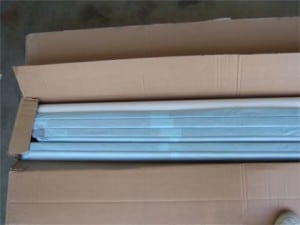
Unpacking the VApex 106" diagonal projector screen
Assembly of the VApex screen is pretty straightforward. Opening the shipping box, you’ll find each of the velour-covered frame pieces wrapped in tissue paper and the screen material is rolled up over a piece of PVC pipe and inserted into a larger PVC pipe to protect it during shipment. There is a bag of plastic screen clips, plastic rods for the screen connection and the frame connecting brackets and hardware are in a separate box.
After removing and unwrapping the frame pieces, you lay them out, velour side down, on a clean soft surface (like a bed sheet or plastic drop cloth). You then insert the frame connecting brackets into each corner. With a screen this size (106” diagonal), the top and bottom frame pieces would be over 100” long if they were a single piece. A box that long can cause a large increase in shipping cost over a smaller box and is likely more expensive to produce, so, with the VApex screen, these frame pieces come in two halves and are connected with a straight connecting bracket. The frame pieces are then secured together with machine screws that connect the frame to the connecting brackets.
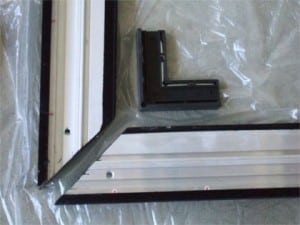
Assembling the screen frame corners
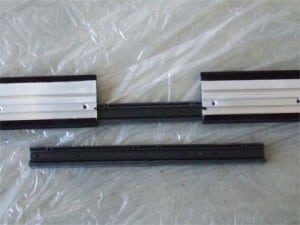
Spitting the frame width into two pieces makes the unit smaller to box and less expensive to ship.
Next, you unroll the screen material inside the screen frame and insert the plastic rods into the pockets on each edge of the screen. Starting on one end of the screen and working from the middle out toward the edges, the screen ends and plastic rod are pushed down into a channel in the frame. Plastic screen clips are then placed over the screen and channel where they clip into the frame, holding the screen in place.
You then repeat the process on the other three sides.
The screen material is slightly undersized for the frame, so when you attach on side opposite one that has already been attached, the screen must be pulled and stretched to seat it into the channel.
Once you’ve completed attaching all four sides, you can go back and add clips as necessary to remove any wrinkles that may remain and you’ve got a finished screen.
The VApex screen comes with wall hanger brackets, as well as screw anchors for drywall (though you should use a stud finder to screw the brackets into studs wherever possible). The brackets need to be installed at the desired height and should be level across the width of the frame. The screen is then placed over the brackets and the brackets fit into a slot that runs the length of the frame. The screen comes with a backing. On paper the screen is "black backed", according to the documentation, but this one wasn't. The back surface provided with this unit was white, not black. I've already got a "what's up with this" email into Visual Apex, and will post the explanation. Mike doesn't recall noting any significant light leakage through the screen, though we'd both be happier with a black backing.
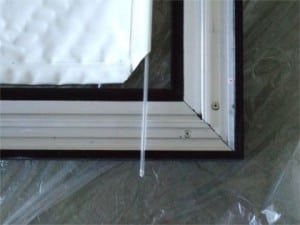
The assembled corner still missing the backcloth
Update: 11/3/09 - Spoke with Visual Apex. They advise that the screen they sent me was a previously used one, that's been around a while, and assure me that the screens in current inventory all have the black backing, as advertised! -art
VApex 106" Diagonal Projection Screen: Performance:
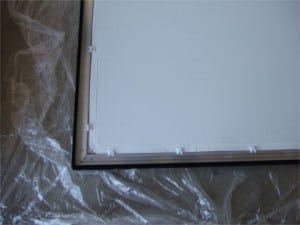
The back of the VApex 106, with backing attached
The VApex screen has a smooth white surface that adds no significant coloration or texture to a displayed image. While I did not measure its gain, it was a typical example of a white matte screen, which usually delivers gains in the 1.0-1.2 range, so its claimed 1.1 gain is probably correct. Also typical of screen material of this type, it has a fairly wide angle of viewing, again probably close to the claimed 80 degrees.
The wide, velour-covered tapered frame looks quite good and gives the impression of a much more expensive screen. Typically, you’d be lucky to get a one-inch frame, painted black, for a screen in this price range. It has some joint misalignment, but it’s not noticeable at normal viewing distances, especially in a darkened theater room. If you’re home theater buff, but trying to save some money in today’s economy, you can have a home theater setup with a 1080p projector and a respectable 106” screen for under $1500. Not bad!
Final notes: Mike’s additional comments include that although he didn’t attempt to measure color shift from the screen, he did observe the screen, along side his Carada Brilliant White (known for having very good color accuracy). He notes that there is a slight shift in color. (We've noted some slight shifts in color in at least two Elite screens we've reviewed, to date, so it's hardly rare.) For those interested, You can read more about the Carada, in its review, a similar sized Carada, will retail for close to $600.). This slight color shift probably isn’t a significant issue for an entry level buyer. Also, should any buyer calibrate their projector, they can take any screen color shift into consideration, as they should.
Bottom line: VA offers up a “private label” lose cost, fixed screen. It’s only available in neutral gain (around 1.0-1.2) matte white, and in sizes from about 90” to 135” diagonal. With a typical size like 106” diagonal selling in the mid-$300s range, (and probably a little less when bundled with a $999 type projector), their screen will likely save you $100 - $200 over any of the lower cost “name brands”, and save close to half, or even more, compared to the top recognized brands. All in all, it’s a nice basic screen. Looks good and works well enough. Mike says assembly is pretty straight forward. I think one of the VApex screens is probably a very good choice for those on a really tight budget. It allows the buyer to put more money toward the projector. A solid entry level product! -art
Best I can figure, there are only about three ways to spend less on a screen:
1. Go with a pull-down screen, but they never (even with tensioning) will be quite as flat as a fixed wall screen, but they do start in the $200 range with tensioning.
2. Use “screen paint” such as Goo, and paint your wall to be a screen. This is basic stuff, I’m not a big fan, as it seems everytime I see a setup using screen paint, that there is more of a tendency to hotspot than with screen materials, and you have to get that wall, very, very smooth.
3. Even worse – just shine it on whatever wall you have. (We needn’t discuss that further!)

The VA 106" projector screen, with wide velour border.
The VApex screens, in general, and the 106" specifically, turn out to be a very nice low cost screen solution. I’m not going to recommend the VA for use with projectors in the $2000+ range. where I believe most people will be better served with a more expensive screen. Still even there, a VApex screen might do in a pinch if there's no money left for more expensive screens.
On the other hand, if you are looking to spend less than $2000 on the whole deal – projector, screen, and perhaps audio, blu-ray player, this VApex screen may well be a good example of “choosing wisely”. I believe Visual Apex was smart to create this line of screens, considering that the low cost will benefit many home theater buyers on a tight budget. -art







